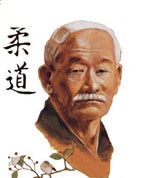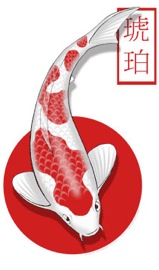THE RED AND WHITE BELT

Judo was established in 1882 by Professor Jigoro Kano. He named his training hall the "Ko-do-kan," or "a place to teach the path."
Based on classical Ju-Jutsu, Jigoro Kano's new art eschewed striking in favour of close quarter grappling, throws and restraints. The core of this system was the "maximum efficient use of energy". A philosophy not just at the heart of many martial arts but a principle useful in many facets of life.
What Jigoro Kano had created went beyond mere technique to include principles for improving the self. To show this, he replaced the suffix justu (technique) in the word "ju-jutsu" with the suffix do (path) and Judo was born.
Karate also follows this precept and you can train in both Karate-Do and Karate-Jutsu.
Though Judo is considered by many as purely a "sport", most enlightened martial artists will accept that throwing a person is one of the most highly skilled and difficult tasks to perform in the martial arts.
In the early 1900s the striking art "Kara-Te" was created as a general name for a variety of Okinawan (and later Japanese) "Te" combat arts. When registering their new Karate art with the government the early Karate Masters borrowed (stole?) aspects of the already established Judo to help gain their much needed official recognition. One aspect they borrowed was the use of specific training suits (gi) complete with the rank/belt system.

Jigoro Kano chose to recognise sixth, seventh, and eighth degree black belts with a special obi made of alternating red and white panels (kōhaku obi - literally translated as "red and white belt"). The white colour was chosen for purity, and red for the intense desire to train and the sacrifices made. The colours red and white are an enduring symbol of Japan, and they have been used in Judo since Jigoro Kano started the first Red and White Tournament in 1884.
In 1943 the Kodokan created the optional all red belt to recognise ninth and tenth degree yudansha.
The selection of red-and-white coloured belts to distinguish the highest ranks may have also been based on a simple cultural preference, according to Meik Skoss, a noted martial arts historian and author of numerous articles about Japanese martial arts. Japanese typically divide groups into red and white sides, based on a pivotal historical event, the Genpei War - a dispute between two rival clans, the Genji and Heike. The Genji used white flags to identify their troops on the battlefield, while the Heike used red flags.
The "kōhaku" obi is often worn for special occasions, but it is not required to be worn at any specific time and the black belt remains the standard obi for all the dan grade ranks.
Though not common in karate, the kōhaku obi is accepted as an option to the standard black belt for high grades, though there is some variance as to when the plain red belt is awarded. Originally the Judo red belt was for 9th and 10th Dan grades, but in Karate it is often used for 8th Dan grades as well.
The decision as to whether the "Master" belts are worn varies according to karate style and association.
The kōhaku and plain red belt are not the only "unusual" belts available in the martial arts, high graded Ju-Jutsu Masters wear a midnight blue belt!
There is also a wide range of "exotic" belts available (mainly in the USA) which are often used in new arts such as XMA (Xtreme Martial Arts).




Apart from being a red and white karate belt the Kōhaku is found in other areas of Japanese culture.
A kōhaku maku (literally red and white curtain) is a type of decorative panel used on special occasions in Japan. It takes its name from the design of vertical red and white stripes, which is known as kōhaku.
Kōhaku maku are hung on walls to give a festive appearance on formal occasions, but are also used on less formal occasions to mark off or decorate spaces.
Collectors of exotic fish will also be familiar with Kōhaku Koi. The Kōhaku has a white body, with red markings across the body.
The Kōhaku breed is believed to be one of the first ornamental carp varieties developed. The variety dates to 1888, when Kunizo Hiroi bred a red-headed female koi with one of his own males, whose markings resembled cherry blossoms, thus creating the now extinct Gosuke bloodline from which all of the known Kōhaku bloodlines established.
The Kōhaku remains one of the most popular breeds of ornamental fish in Japan.


